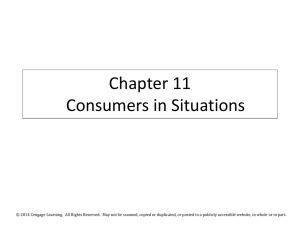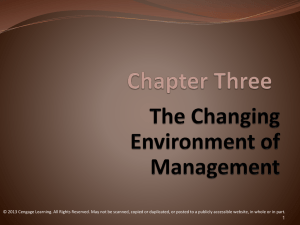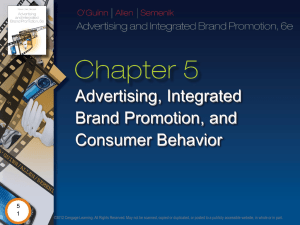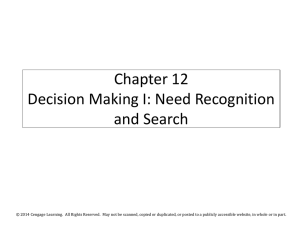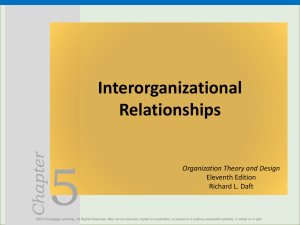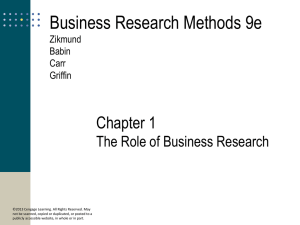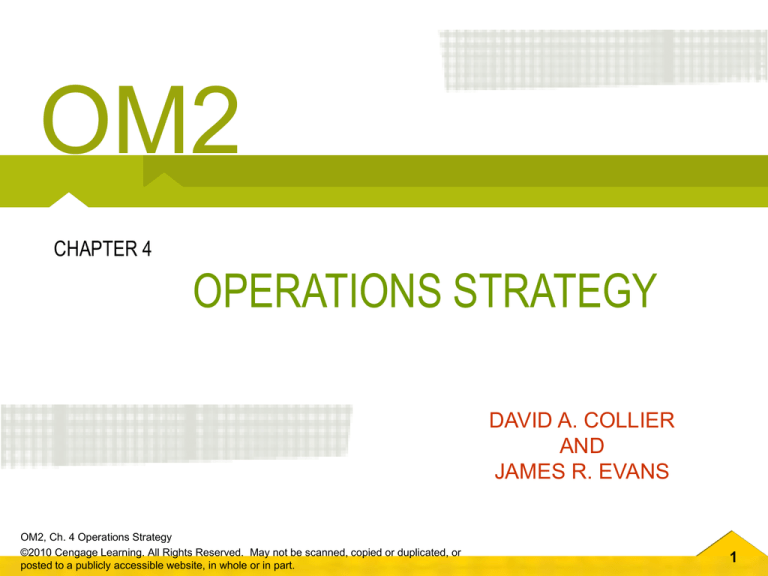
OM2
CHAPTER 4
OPERATIONS STRATEGY
DAVID A. COLLIER
AND
JAMES R. EVANS
OM2, Ch. 4 Operations Strategy
©2010 Cengage Learning. All Rights Reserved. May not be scanned, copied or duplicated, or
posted to a publicly accessible website, in whole or in part.
1
Chapter 4 Learning Outcomes
learning outcomes
LO1 Explain how organizations seek to gain
competitive advantage.
LO2 Explain approaches for understanding customer
requirements.
LO3 Describe how customers evaluate goods and
services.
LO4 Explain the five key competitive priorities.
LO5 Explain the role of OM and operations strategy in
strategic planning.
LO6 Describe Hill’s framework for operations strategy.
OM2, Ch. 4 Operations Strategy
©2010 Cengage Learning. All Rights Reserved. May not be scanned, copied or duplicated, or
posted to a publicly accessible website, in whole or in part.
22
Chapter 4 Operations Strategy
ival golf club equipment manufacturers TaylorMade and Callaway are
both based in Carlsbad, California. That’s about where the similarity
ends. Callaway made clubs for average golfers, while TaylorMade took
the clubs pro golfers were using and adjusted them to suit amateurs. Callaway
focused on management and production efficiency while sticking to core product
designs, much the way Ford built cars around a basic chassis. TaylorMade,
however, was constantly reinventing its products lines, and in an industry that
expected product cycles to last 18 months or longer, began releasing new drivers
and irons in rapid-fire succession. Even new product launches show the
difference between these companies: Callaway typically launched products with
lengthy PowerPoint presentations, while TaylorMade turned them into huge pep
rallies. TaylorMade’s strategy seems to have paid off; late in 2003 it overtook
Callaway in market share for metalwoods.
What implications would the different strategies chosen
by Callaway and TaylorMade – sticking to core product designs versus continual
innovation – have for key operations management decisions such as
outsourcing and designing flexibility into their processes?
What do you think?
OM2, Ch. 4 Operations Strategy
©2010 Cengage Learning. All Rights Reserved. May not be scanned, copied or duplicated, or
posted to a publicly accessible website, in whole or in part.
33
Chapter 4 Operations Strategy
•
What implications would the different strategies chosen
by Callaway and TaylorMade – sticking to core product
designs versus continual innovation – have for key
operations management decisions such as outsourcing
and designing flexibility into their processes? (Consider
the decision areas discussed in Chapter 2 for designing
value chains.)
•
Should organizations create strategies in response to
customer wants and needs, or should they create
strategies and then try to influence customer behavior
to meet the strategic goals?
OM2, Ch. 4 Operations Strategy
©2010 Cengage Learning. All Rights Reserved. May not be scanned, copied or duplicated, or
posted to a publicly accessible website, in whole or in part.
44
Chapter 4 Operations Strategy
Competitive Priorities
• Competitive advantage denotes a firm’s
ability to achieve market and financial
superiority over its competitors.
• Competitive priorities represent the
strategic emphasis that a firm places on
certain performance measures and
operational capabilities within a value chain.
OM2, Ch. 4 Operations Strategy
©2010 Cengage Learning. All Rights Reserved. May not be scanned, copied or duplicated, or
posted to a publicly accessible website, in whole or in part.
55
Chapter 4 Operations Strategy
Understanding Customer Requirements
A Japanese professor, Noriaki Kano, suggested three
classes of customer requirements:
Dissatisfiers: requirements that are expected in a good
or service. If these features are not present, the
customer is dissatisfied, sometimes very dissatisfied.
Satisfiers: requirements that customers say they want.
Exciters/delighters: new or innovative good or
service features that customers do not expect.
Examples?
OM2, Ch. 4 Operations Strategy
©2010 Cengage Learning. All Rights Reserved. May not be scanned, copied or duplicated, or
posted to a publicly accessible website, in whole or in part.
66
Chapter 4 Operations Strategy
Understanding Customer Requirements
• Basic customer expectations—dissatisfiers and
satisfiers—are generally considered the minimum
performance level required to stay in business
and are often called order qualifiers.
• Order winners are goods and service features
and performance characteristics that
differentiate one customer benefit package from
another, and win the customer's business.
OM2, Ch. 4 Operations Strategy
©2010 Cengage Learning. All Rights Reserved. May not be scanned, copied or duplicated, or
posted to a publicly accessible website, in whole or in part.
77
Chapter 4 Operations Strategy
Understanding Customer Requirements
• Search attributes are those that a customer
can determine prior to purchasing the goods
and/or services. These attributes include things
like color, price, freshness, style, fit, feel,
hardness, and smell.
• Goods such as supermarket food, furniture,
clothing, automobiles, and houses are high in
search attributes.
OM2, Ch. 4 Operations Strategy
©2010 Cengage Learning. All Rights Reserved. May not be scanned, copied or duplicated, or
posted to a publicly accessible website, in whole or in part.
88
Chapter 4 Operations Strategy
Understanding Customer Requirements
• Experience attributes are those that can be
discerned only after purchase or during
consumption or use.
• Examples of these attributes are friendliness,
taste, wearability, safety, fun, and customer
satisfaction.
OM2, Ch. 4 Operations Strategy
©2010 Cengage Learning. All Rights Reserved. May not be scanned, copied or duplicated, or
posted to a publicly accessible website, in whole or in part.
99
Chapter 4 Operations Strategy
Understanding Customer Requirements
• Credence attributes are any aspects of a good
or service that the customer must believe in, but
cannot personally evaluate even after purchase
and consumption.
• Examples would include the expertise of a
surgeon or mechanic, the knowledge of a tax
advisor, or the accuracy of tax preparation
software.
OM2, Ch. 4 Operations Strategy
©2010 Cengage Learning. All Rights Reserved. May not be scanned, copied or duplicated, or
posted to a publicly accessible website, in whole or in part.
1010
Exhibit 4.1
How Customers Evaluate Goods and Services
OM2, Ch. 4 Operations Strategy
©2010 Cengage Learning. All Rights Reserved. May not be scanned, copied or duplicated, or
posted to a publicly accessible website, in whole or in part.
1111
Chapter 4 Operations Strategy
Customers evaluate services in ways that are often different
from goods, such as:
• Customers seek and rely more on information from personal sources
than from non-personal sources when evaluating services prior to
purchase.
• Customers use a variety of perceptual features in evaluating services.
• Customers normally adopt innovations in services more slowly than
they adopt innovation in goods.
• Customers perceive greater risks when buying services than when
buying goods.
• Dissatisfaction with services is often the result of customers’ inability
to properly perform or co-produce their part of the service.
These insights help to explain why it is more difficult to design services
and service processes than goods and manufacturing operations.
OM2, Ch. 4 Operations Strategy
©2010 Cengage Learning. All Rights Reserved. May not be scanned, copied or duplicated, or
posted to a publicly accessible website, in whole or in part.
1212
Chapter 4 Operations Strategy
Competitive Priorities
• Cost
• Quality
• Time
• Flexibility
• Innovation
OM2, Ch. 4 Operations Strategy
©2010 Cengage Learning. All Rights Reserved. May not be scanned, copied or duplicated, or
posted to a publicly accessible website, in whole or in part.
1313
Chapter 4 Operations Strategy
Competitive Priorities
• Every organization is concerned with building
and sustaining a competitive advantage in its
markets (see BMW).
• A strong competitive advantage is driven by
customer needs and aligns the organization's
resources with its business opportunities.
• A strong competitive advantage is difficult to
copy, often because of a firm’s culture, habits,
or sunk costs.
OM2, Ch. 4 Operations Strategy
©2010 Cengage Learning. All Rights Reserved. May not be scanned, copied or duplicated, or
posted to a publicly accessible website, in whole or in part.
1414
Chapter 4 Operations Strategy
Competitive Priority – Cost
• Almost every industry has a low price market
segment.
• Low-cost strategy firms: Honda Motor Co.,
Marriott's Fairfield Inns, Merck-Medco On-line
Pharmacy, Southwest Airlines, and Wal-Mart's
Sam's Club.
• Southwest Airlines is one of the few airlines that have
been profitable during the 2001-2005 period. A low
cost strategy can reshape industry structure such as
in the airline industry (see Southwest Airlines).
OM2, Ch. 4 Operations Strategy
©2010 Cengage Learning. All Rights Reserved. May not be scanned, copied or duplicated, or
posted to a publicly accessible website, in whole or in part.
1515
Chapter 4 Operations Strategy
Coffee Wars
Starbucks is facing growing competition from competitors
like Dunkin Donuts and McDonalds for a good and
inexpensive cup of coffee. McDonalds introduced “premium
roast coffee” a few years ago, which was cited by Consumer
Reports as the “cheapest and best.” More recently, it has
also added separate coffee bars – “McCafes.” --- Now
Starbucks is fighting back and playing the McDonald’s game:
Starbucks is testing a $1 cup of coffee with free refills in the
Seattle area. The CEO of Starbucks, Howard Schultz, says
this is not a new strategy but that he believes that price is
the number one competitive priority and that Starbucks lost
its focus on customer service in recent years as it
concentrated on growth.
OM2, Ch. 4 Operations Strategy
©2010 Cengage Learning. All Rights Reserved. May not be scanned, copied or duplicated, or
posted to a publicly accessible website, in whole or in part.
1616
Chapter 4 Operations Strategy
Competitive Priority – Quality
PIMS Associates, Inc., a subsidiary of the Strategic Planning
Institute, found that:
•
•
•
•
Businesses offering premium quality goods usually have
large market shares and were early entrants into their
markets.
Quality is positively and significantly related to a higher
return on investment for almost all kinds of market
situations.
A strategy of quality improvement usually leads to
increased market share, but at a cost in terms of reduced
short-run profitability.
High goods quality producers can usually charge premium
prices.
OM2, Ch. 4 Operations Strategy
©2010 Cengage Learning. All Rights Reserved. May not be scanned, copied or duplicated, or
posted to a publicly accessible website, in whole or in part.
1717
Exhibit 4.2
Interlinking Quality and Profitability Performance
OM2, Ch. 4 Operations Strategy
©2010 Cengage Learning. All Rights Reserved. May not be scanned, copied or duplicated, or
posted to a publicly accessible website, in whole or in part.
1818
Chapter 4 Operations Strategy
Competitive Priority – Time
• Time is perhaps the most important source of
competitive advantage.
• Customers demand quick response, short
waiting times, and consistency in performance.
• Many firms use time as a competitive weapon
to create and deliver superior goods and
services, such as Charles Schwab, Clarke
American Checks, CNN, Dell, FedEx, and
Wal-Mart.
OM2, Ch. 4 Operations Strategy
©2010 Cengage Learning. All Rights Reserved. May not be scanned, copied or duplicated, or
posted to a publicly accessible website, in whole or in part.
1919
Chapter 4 Operations Strategy
Competitive Priority – Time
Reductions in flow time serve two purposes:
• First, they speed up work processes so that
customer response is improved. Deliveries can
be made faster, and more often on-time.
• Second, reductions in flow time can be
accomplished only by streamlining and
simplifying processes and value chains to
eliminate non-value-added steps such as
rework and waiting time.
OM2, Ch. 4 Operations Strategy
©2010 Cengage Learning. All Rights Reserved. May not be scanned, copied or duplicated, or
posted to a publicly accessible website, in whole or in part.
2020
Chapter 4 Operations Strategy
Competitive Priority – Time
• Flow time reductions often drive simultaneous
improvements in quality, cost, and productivity
(see Hyundai Motor Co.).
OM2, Ch. 4 Operations Strategy
©2010 Cengage Learning. All Rights Reserved. May not be scanned, copied or duplicated, or
posted to a publicly accessible website, in whole or in part.
2121
Chapter 4 Operations Strategy
Competitive Priority – Flexibility
• Mass customization is being able to make
whatever goods and services the customer
wants, at any volume, at any time for anybody,
and for a global organization, from any place in
the world.
OM2, Ch. 4 Operations Strategy
©2010 Cengage Learning. All Rights Reserved. May not be scanned, copied or duplicated, or
posted to a publicly accessible website, in whole or in part.
2222
Chapter 4 Operations Strategy
Competitive Priority – Flexibility
• Mass customization requires companies to align
their activities around differentiated customer
segments and to design goods, services, and
operations around flexibility.
• High-levels of flexibility might require special
strategies such as modular designs,
interchangeable components, and
postponement strategies.
OM2, Ch. 4 Operations Strategy
©2010 Cengage Learning. All Rights Reserved. May not be scanned, copied or duplicated, or
posted to a publicly accessible website, in whole or in part.
2323
Chapter 4 Operations Strategy
Competitive Priority – Flexibility
• Flexible operations require sharing
manufacturing lines and specialized training for
employees.
• Flexible operations may also require attention
to outsourcing decisions, agreements with key
suppliers, and innovative partnering
arrangements, because delayed shipments and
a complex supply chain can hinder flexibility.
OM2, Ch. 4 Operations Strategy
©2010 Cengage Learning. All Rights Reserved. May not be scanned, copied or duplicated, or
posted to a publicly accessible website, in whole or in part.
2424
Chapter 4 Operations Strategy
Competitive Priority – Flexibility
•
Examples include:
Sign-tic company signs that are uniquely designed for
each customer from a standard base sign structure
business consulting
Levi’s jeans that are cut to exact measurements
personal Web pages
estate planning
Harley-Davidson bikes
cell phones customized in different colors, sizes, and
shapes
personal weight training programs
modular furniture that customers can configure to their
unique needs and tastes
OM2, Ch. 4 Operations Strategy
©2010 Cengage Learning. All Rights Reserved. May not be scanned, copied or duplicated, or
posted to a publicly accessible website, in whole or in part.
2525
Chapter 4 Operations Strategy
Competitive Priority – Innovation
• Innovation is the discovery and practical
application or commercialization of a device,
method, or idea that differs from existing
norms.
• Innovations in all forms encapsulate human
knowledge.
OM2, Ch. 4 Operations Strategy
©2010 Cengage Learning. All Rights Reserved. May not be scanned, copied or duplicated, or
posted to a publicly accessible website, in whole or in part.
2626
Chapter 4 Operations Strategy
Competitive Priority – Innovation
• Innovations take many forms, such as:
Physical goods such as telephones,
automobiles, refrigerators, computers,
optical fiber, satellites, and cell phones.
Services such as self-service, all-suite
hotels, health maintenance organizations,
and Internet banking.
OM2, Ch. 4 Operations Strategy
©2010 Cengage Learning. All Rights Reserved. May not be scanned, copied or duplicated, or
posted to a publicly accessible website, in whole or in part.
2727
Chapter 4 Operations Strategy
Competitive Priority – Innovation
• Innovations take many forms, such as:
Manufacturing such as computer-aided
design, robotic automation, and smart tags.
Management practices such as customer
satisfaction surveys, quantitative decision
models, and Six Sigma.
OM2, Ch. 4 Operations Strategy
©2010 Cengage Learning. All Rights Reserved. May not be scanned, copied or duplicated, or
posted to a publicly accessible website, in whole or in part.
2828
Chapter 4 Operations Strategy
Solved Problem
Define the customer benefit package for a health club or
recreation center and use this to describe the
organization’s strategic mission, strategy, competitive
priorities, and how it wins customers.
OM2, Ch. 4 Operations Strategy
©2010 Cengage Learning. All Rights Reserved. May not be scanned, copied or duplicated, or
posted to a publicly accessible website, in whole or in part.
2929
Chapter 4 Operations Strategy
Solution
Food
Child
Care
Mission: The mission of our health
club is to offer many pathways to a
healthy living style and body.
Personal
Trainer
Exercise
Classes
Healthy
Mind and
Diet and
Body
Swim
Lessons
Nutrition
Massage
Services
Strategy: We strive to provide our customers with
superior:
• Customer convenience (location, food, communication,
schedules, etc.)
• Clean facilities, equipment, uniforms, parking lot, and
the like
• Friendly professional staff that care about you
• Ways to improve and maintain your body and mind's
health and well being
OM2, Ch. 4 Operations Strategy
©2010 Cengage Learning. All Rights Reserved. May not be scanned, copied or duplicated, or
posted to a publicly accessible website, in whole or in part.
3030
Chapter 4 Operations Strategy
Solution - continued
How to win customers? Providing a full
service health club with superior service, staff,
and facilities.
Competitive Priorities:
1. Many pathways to healthy living and a healthy
body (design flexibility)
2. Friendly professional staff and service
encounters (service quality)
3. Everything is super-clean (goods and
environmental quality)
4. Customer convenience in all respects (time)
5. Price (cost)
OM2, Ch. 4 Operations Strategy
©2010 Cengage Learning. All Rights Reserved. May not be scanned, copied or duplicated, or
posted to a publicly accessible website, in whole or in part.
3131
Chapter 4 Operations Strategy
Solution - continued
Example Health Club Processes
•
The food ordering and supply, preparation, delivery, and cleanup processes define the food service value chain.
•
The childcare process includes rigorous procedures for
checking children in and out of the childcare area.
•
The swimming lesson process includes a sign-up phase,
potential participant medical examination phase, and a series of
classes taught by certified swimming instructors who are
trained in emergency services such as CPR.
•
The personal trainer process requires high design flexibility,
since each exercise and training program is customized to the
individual.
OM2, Ch. 4 Operations Strategy
©2010 Cengage Learning. All Rights Reserved. May not be scanned, copied or duplicated, or
posted to a publicly accessible website, in whole or in part.
3232
Chapter 4 Operations Strategy
Strategic Planning
• Strategy is a pattern or plan that integrates an
organization’s major goals, policies, and action
sequences into a cohesive whole.
• Effective strategies develop around a few key
competitive priorities, such as low cost or fast
service time, which provide a focus for the
entire organization and exploit an organization’s
core competencies (the strengths unique to
that organization).
OM2, Ch. 4 Operations Strategy
©2010 Cengage Learning. All Rights Reserved. May not be scanned, copied or duplicated, or
posted to a publicly accessible website, in whole or in part.
3333
Chapter 4 Operations Strategy
Strategic Planning
• Strategic planning is the process of determining
long-term goals, policies, and plans for an
organization.
• The businesses in which the firm will participate are
often called strategic business units (SBUs), and
are usually defined as families of goods or services
having similar characteristics or methods of creation.
• Strategy is the result of a series of hierarchical
decisions about goals, directions, and resources.
OM2, Ch. 4 Operations Strategy
©2010 Cengage Learning. All Rights Reserved. May not be scanned, copied or duplicated, or
posted to a publicly accessible website, in whole or in part.
3434
Chapter 4 Operations Strategy
Strategic Planning
Most large organizations have three levels of
strategy:
• Corporate strategy is necessary to define
the businesses in which the corporation will
participate and develop plans for the
acquisition and allocation of resources among
those businesses.
OM2, Ch. 4 Operations Strategy
©2010 Cengage Learning. All Rights Reserved. May not be scanned, copied or duplicated, or
posted to a publicly accessible website, in whole or in part.
3535
Chapter 4 Operations Strategy
Strategic Planning
Most large organizations have three levels of
strategy:
• A business strategy defines the focus for
SBUs. The major decisions involve which
markets to pursue and how best to compete in
those markets; that is, what competitive
priorities the firm should pursue.
OM2, Ch. 4 Operations Strategy
©2010 Cengage Learning. All Rights Reserved. May not be scanned, copied or duplicated, or
posted to a publicly accessible website, in whole or in part.
3636
Chapter 4 Operations Strategy
Strategic Planning
Most large organizations have three levels of
strategy:
• A functional strategy is the set of decisions
that each functional area—marketing, finance,
operations, research and development,
engineering, and so on—develops to support
its particular business strategy.
OM2, Ch. 4 Operations Strategy
©2010 Cengage Learning. All Rights Reserved. May not be scanned, copied or duplicated, or
posted to a publicly accessible website, in whole or in part.
3737
Chapter 4 Operations Strategy
Strategic Planning
• The operations strategy defines how an
organization will execute its chosen
business strategies.
• It is how an organization’s processes are
designed and organized to produce the type
of goods and services to support the
corporate and business strategies.
OM2, Ch. 4 Operations Strategy
©2010 Cengage Learning. All Rights Reserved. May not be scanned, copied or duplicated, or
posted to a publicly accessible website, in whole or in part.
3838
Chapter 4 Operations Strategy
Strategic Planning
• Managers recognize that the value (supply)
chain can be leveraged to provide a distinct
competitive advantage, and that operations is
a core competency for the organization.
• Whoever has superior operational capability
over the long term is the odds-on-favorite to win
the industry shakeout.
OM2, Ch. 4 Operations Strategy
©2010 Cengage Learning. All Rights Reserved. May not be scanned, copied or duplicated, or
posted to a publicly accessible website, in whole or in part.
3939
Chapter 4 Operations Strategy
Pal’s Strategic Planning Process
• Values are attitudes and policies for all
employees to follow that direct the journey to
achieving the organization’s vision.
• Values are reinforced through conscious and
subconscious behavior at all levels of the
organization.
OM2, Ch. 4 Operations Strategy
©2010 Cengage Learning. All Rights Reserved. May not be scanned, copied or duplicated, or
posted to a publicly accessible website, in whole or in part.
4040
Chapter 4 Operations Strategy
Pal’s Strategic Planning Process
•
•
The strategic mission of a firm defines its reason for
existence.
The strategic vision describes where the organization
is headed and what it
Vision Statement
intends to be.
To be the preferred quick service restaurant
in our market achieving the largest market
share by providing:
Pal’s strategic vision is
• The quickest, friendliest, most accurate
service available
• A focused menu that delights customers
• Daily excellence in our product, service,
and systems execution
• Clean, organized, sanitary facilities
• Exceptional value
OM2, Ch. 4 Operations Strategy
©2010 Cengage Learning. All Rights Reserved. May not be scanned, copied or duplicated, or
posted to a publicly accessible website, in whole or in part.
4141
Chapter 4 Operations Strategy
Pal’s Operations Strategy
What kind of an operations strategy might a company like
Pal’s Sudden Service have? What are the OM implications?
• The quickest, friendliest, most accurate service available.
• A focused menu that delights customers.
• Daily excellence in product, service, and systems
execution.
• Clean, organized, sanitary facilities.
• Exceptional value.
OM2, Ch. 4 Operations Strategy
©2010 Cengage Learning. All Rights Reserved. May not be scanned, copied or duplicated, or
posted to a publicly accessible website, in whole or in part.
4242
Chapter 4 Operations Strategy
Professor Terry Hill’s Strategy Development Framework
Operations design choices are the decisions management
must make as to what type of process structure is best suited
to produce goods or create services. (See Exhibits 4.3 and 4.4)
•
Types of processes and alternative designs
•
Supply chain integration and outsourcing
•
Technology
•
Capacity and facilities (size, timing, location)
•
Inventory
•
Trade-off analysis
OM2, Ch. 4 Operations Strategy
©2010 Cengage Learning. All Rights Reserved. May not be scanned, copied or duplicated, or
posted to a publicly accessible website, in whole or in part.
4343
Exhibit 4.3
Hill’s Strategy Development Framework
Source: T. Hill, Manufacturing Strategy: Text and Cases, 2nd ed., Burr Ridge, IL: Irwin Publishers, 1994, p. 28
OM2, Ch. 4 Operations Strategy
©2010 Cengage Learning. All Rights Reserved. May not be scanned, copied or duplicated, or
posted to a publicly accessible website, in whole or in part.
4444
Chapter 4 Operations Strategy
Professor Terry Hill’s Strategy Development Framework
Infrastructure focuses on the nonprocess
features and capabilities of the organization (see
Exhibits 4.3 and 4.4) and includes:
•
•
•
•
•
•
•
workforce
operating plans and control system(s)
quality control
organizational structure
compensation systems
learning and innovation systems
support services
OM2, Ch. 4 Operations Strategy
©2010 Cengage Learning. All Rights Reserved. May not be scanned, copied or duplicated, or
posted to a publicly accessible website, in whole or in part.
4545
Exhibit 4.4
Four Key Decision Loops in Terry Hill’s Generic Strategy Framework
OM2, Ch. 4 Operations Strategy
©2010 Cengage Learning. All Rights Reserved. May not be scanned, copied or duplicated, or
posted to a publicly accessible website, in whole or in part.
4646
Chapter 4 Operations Strategy
Professor Hill’s Strategy Framework Applied to McDonald’s
•
McDonald's vision is to be the world's best quick
service restaurant experience. Being the best means
providing outstanding quality, service, cleanliness, and
value, so that we make every customer in every restaurant
smile. To achieve our vision, we focus on three worldwide
strategies:
(1) Be the Best Employer
(2) Deliver Operational Excellence
(3) Achieve Enduring Profitable Growth
•
Customer Benefit Package Design and Strategy (see Ex. 4.5)
•
Strategy Development for McDonald’s (see Exhibit 4.6)
OM2, Ch. 4 Operations Strategy
©2010 Cengage Learning. All Rights Reserved. May not be scanned, copied or duplicated, or
posted to a publicly accessible website, in whole or in part.
4747
Exhibit 4.5
McDonald’s Customer Benefit Package
OM2, Ch. 4 Operations Strategy
©2010 Cengage Learning. All Rights Reserved. May not be scanned, copied or duplicated, or
posted to a publicly accessible website, in whole or in part.
4848
Exhibit 4.6
Applying Hill’s Strategy Development Framework to McDonald’s
(slide 1)
OM2, Ch. 4 Operations Strategy
©2010 Cengage Learning. All Rights Reserved. May not be scanned, copied or duplicated, or
posted to a publicly accessible website, in whole or in part.
4949
Exhibit 4.6
Applying Hill’s Strategy Development Framework to McDonald’s
(slide 2)
OM2, Ch. 4 Operations Strategy
©2010 Cengage Learning. All Rights Reserved. May not be scanned, copied or duplicated, or
posted to a publicly accessible website, in whole or in part.
5050
Chapter 4 Operations Strategy
The Lawn Care Company Case Study
1. Define Lawn Care’s current strategic mission, strategy, competitive
priorities, value chain, and how it wins customers. What are the order
qualifiers and winners?
2. Draw the major stages of the value chain with and without an
application service and comment on the role of operations in each.
3. What problems, if any, do you see with Lawn Care’s current strategy,
vision, customer benefit package and value chain design, and pre- and
post-services?
4. What pre- and post-services could Lawn Care offer its customers to
complement the sale of its physical goods, such as grass seed and
fertilizer?
5. Redo questions (1) to (4) and provide a new or revised strategy and
associated customer benefit package and value chain where services play
a larger role.
6. What are your final recommendations?
OM2, Ch. 4 Operations Strategy
©2010 Cengage Learning. All Rights Reserved. May not be scanned, copied or duplicated, or
posted to a publicly accessible website, in whole or in part.
5151


